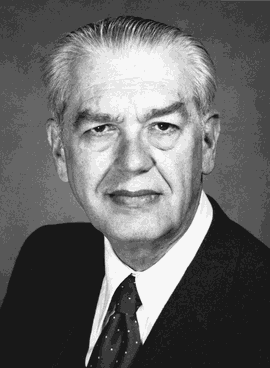John Bissell Carroll facts for kids
Quick facts for kids
John Bissell Carroll
|
|
|---|---|
 |
|
| Born |
John Bissell Carroll
June 5, 1916 Hartford, Connecticut, U.S.
|
| Died | July 1, 2003 (aged 87) Fairbanks, Alaska, U.S.
|
| Citizenship | American |
| Alma mater | University of Chicago |
| Known for |
|
| Awards | E. L. Thorndike Award (1970) James McKeen Cattell Fellow Award (1998) |
| Scientific career | |
| Fields |
|
| Institutions |
|
John Bissell Carroll (born June 5, 1916 – died July 1, 2003) was an American psychologist. He was famous for his work in psychology, linguistics, and psychometrics. These fields study how people think, learn languages, and measure intelligence.
Contents
John Carroll's Early Life
John Carroll was born in Hartford, Connecticut. From a young age, he loved music and languages. When he was thirteen, he became friends with Benjamin Lee Whorf. They talked about how culture and language are connected. Later, Carroll helped to edit and publish Whorf's book, Language, Thought and Reality, in 1956.
Education and Discoveries
Carroll went to Wesleyan University. He studied Classics and graduated with top honors in 1937. He then went to the University of Minnesota to get his PhD in Psychology.
He started studying with B. F. Skinner. But Carroll soon found he was more interested in studying many people at once. Skinner's approach focused on one person at a time. So, Skinner sent Carroll to L. L. Thurstone at the University of Chicago. There, Carroll could study psychometrics, which is about measuring mental abilities. He focused on how people learn languages. In 1941, he finished his main project, called “A Factor Analysis of Verbal Abilities.”
Where John Carroll Worked
After finishing his studies, John Carroll worked at several places. His first job was at Mount Holyoke College from 1940 to 1942. He married Mary Searle, who also studied psychology there.
He also taught at Indiana University and the University of Chicago. Later, he worked at the Harvard Graduate School of Education and the University of North Carolina at Chapel Hill. Besides teaching, Carroll was a psychologist for the United States Navy and the Department of the Army. He also worked for the Educational Testing Service, which creates tests like the SAT.
Key Contributions and Ideas
John Carroll made many important contributions to how we understand learning and intelligence.
Developing Language Tests
In the 1950s, Carroll worked on a test to see how easily people could learn new languages. This test was called the Modern Language Aptitude Test (MLAT). The U.S. Army needed a way to find people who could quickly learn foreign languages for training.
Carroll received money from the Carnegie Corporation for this research. He worked with Stanley Sapon and the U.S. Army-Air Force to create the MLAT. The test was first published in 1959. It was still used by some people even in 2004.
New Ways to Test Language Skills
In 1961, Carroll wrote a paper about testing English language skills for foreign students. He questioned the common way of testing, called "discrete-point testing." This method tests one small piece of knowledge at a time.
Carroll suggested using "integrative testing" instead. This means each test question would make you use several skills or pieces of knowledge at once. He believed this showed a more natural understanding of a language. Carroll's ideas influenced the design of the Test of English as a Foreign Language (TOEFL). The TOEFL test combines both discrete-point and integrative methods.
Carroll's Model of School Learning
In 1962, Carroll shared his Model of School Learning. This model helped predict how well students would do in school. It looked at two main things:
- Individual differences: These include a student's general intelligence, natural abilities, and how motivated they are.
- Instructional variables: These relate to how good the teaching is and how much time is spent learning.
The Three Stratum Theory
In 1993, Carroll published a large book called Human Cognitive Abilities: A Survey of Factor-Analytic Studies. In this book, he introduced his Three Stratum Theory. This theory explains that human intelligence has three different levels:
- Narrow abilities: These are very specific skills, like memory for words or speed of thinking.
- Broad abilities: These are wider categories, like fluid intelligence (problem-solving) or crystallized intelligence (knowledge from experience).
- General intelligence (g factor): This is one overall ability that affects all other mental tasks.
Mainstream Science on Intelligence
In 1994, Carroll was one of 52 scientists who signed a public statement. It was called Mainstream Science on Intelligence. This statement was published in the Wall Street Journal. It aimed to correct what the scientists felt were wrong ideas in the media about intelligence research. This happened after a book called The Bell Curve came out.
Selected Publications
Here are some of the important books and articles John Carroll wrote:
- Carroll, J B 1956 Language, Thought, and Reality: Selected Writings of Benjamin Lee Whorf M.I.T. Press, Boston.
- Carroll, J B 1993 Human Cognitive Abilities: A survey of factor-analytic studies Cambridge University Press, Cambridge.
- Carroll, J B, Davies, P, & Richman, B 1971 The American Heritage Word Frequency Book. Houghton Mifflin, New York.
- Carroll, J B, Sapon, S M 1959 Modern Language Aptitude Test The Psychological Corporation, San Antonio, Texas.
- Carroll, J B, 1961 "Fundamental considerations in testing for English language proficiency of foreign students". In Testing Center for Applied Linguistics, Washington, DC.
See also
 In Spanish: John B. Carroll para niños
In Spanish: John B. Carroll para niños
- Cattell–Horn–Carroll theory
- g factor
- Educational psychology
- Language education

